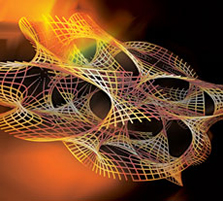
s
there one universe or many? That mind-dilating concept which has been
challenging scientists in recent years is the subject of a book edited
by Bernard Carr, resulting from three conferences held at Stanford and
Cambridge Universities with the support of the Foundation.


Carr, professor of mathematics and astronomy at Queen Mary, University
of London, compiled the work of 26 contributors, ranging from cosmologists
and particle physicists to philosophers, under the title
Universe
or Multiverse? The views represented are similarly varied, encompassing
all shades of opinion on multiverse theory, from the firmly committed
to the deeply skeptical.

“What is clear,” says Carr, “is that what we call our universe—our visible
universe—has to be only a small part of a much larger entity, because
in the Big Bang picture you can only see to the distance light has travelled
since the Big Bang, roughly 40 billion light years.” But the multiverse
concept goes beyond this by positing other universes that are completely
disconnected from ours. There are several theories that predict this:
the cyclic model, the inflationary model, the brane model (in which universes
are spread out in an extra dimension), the ‘many worlds’ model of quantum
mechanics, and the string landscape model. There is also the notion that
there could be different universes corresponding to all possible laws
of physics.

All of this varied tapestry of speculation is considered in the book,
whose contributors include Martin Rees, Stephen Hawking, and recent Templeton
laureate John Barrow. The book was launched at the conclusion of the
Templeton-sponsored strategy and planning workshop, “Toward a New Philosophy
of Cosmology,” held at the Royal Society in London in May 2007.

This workshop was convened to consider “the state of the field” and was
attended by many distinguished scientists, including Professor Lord Rees,
who is president of the Royal Society, Master of Trinity College, Cambridge,
and Astronomer Royal. The workshop considered such questions as: What
are the laws of nature? Why do they exist? Does scientific explanation
have intrinsic limits in cosmology? Why life? Why fine-tuning? Why the
universe? Is there one universe or many?
 Universe
or Multiverse?
Universe
or Multiverse? is an attempt to address that last question in
some detail. Carr rejects the frequently voiced criticism that this debate
belongs to the realm of philosophy rather than science. “It’s certainly
true that the multiverse is not part of science as we normally think
of it, but that may just mean we need to change the nature of science.
It’s true you can’t see these other universes, but there are lots of
examples of things in physics that you can’t see. For example, nobody
can see inside a black hole and yet everybody accepts that discussion
of such regions is well within the domain of physics,” he says, before
adding, “No one’s ever seen a quark.”

Is God incompatible with a multiverse? “Some people say ‘God or multiverse’
but that’s very naïve because if you’ve got a multiverse you could still
have God. My personal view is that if God could create one universe,
He could create as many as He wanted.” Carr points out that what gives
an extra edge to the universe/multiverse controversy is the fact that,
if there is only one universe, there is a problem explaining the fine-tuning
of the physical constants required for life. A multiverse could remove
the need for a “fine-tuner” (God?), which would be a relief to some physicists
who are uneasy about the quasi-theological implications of fine-tuning.



